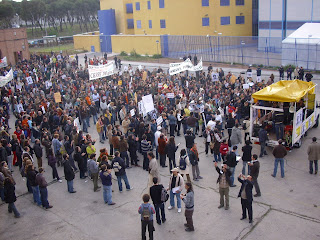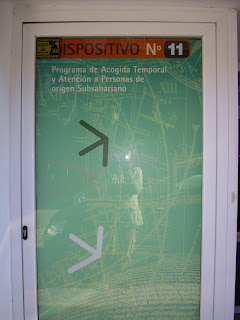What happens to public policy on immigration in Madrid?
The Integration Plan and the Madrid Plan
In 2004 and 2006, and Madrid City Council had, respectively, two separate plans of action to address the challenge posed by the increasing foreign population in this community, occurred in recent years.
Integration Plan 2006-08 of the Community of Madrid (known as Plan of integration) was conceived as a bi Plan, as stated seek the involvement of both the indigenous population and the migrant population in the pursuit of social integration. On paper, the Plan did not contemplate, in general, opening new devices, but the strengthening and empowerment through programs, activities, courses, campaigns and studies of existing resources, in areas as diverse as employment, housing, education, social services, health, public opinion, participation ... As a key devices within the diversity management, provided for the consolidation of the CASI (Center for Immigrant Social Care), whose functions would complement the establishment of CEPI (Center for Participation and Integration), designed as meeting places between locals and migrants, though separated by national origin.
For its part, the City of Madrid, Madrid had its first Plan Intercultural Social Affairs (known simply as Madrid Plan) as an innovative and ambitious, as it claims to want to go beyond the mere integration of the migrant population "chasing the momentum and improve coexistence between all local citizens." City Council action was defined along three axes (joint coexistence model, standardization in access to resources and the promotion and improvement of living) to be distributed among 37 devices start-ups, but ultimately come to only 34 materialize.
As
already the norm in the field of social intervention, management of the resources of both the Integration Plan and the Madrid Plan was engaged with a range of NGOs, foundations and social enterprises, Red Cross, CEAR, Group 5, MPDL , ACCEM, Independent or The Distaff Foundation were some of them.
rising inequality
This year, both plans come to an end. In the period that separates us from the start, the result we find, in socioeconomic terms, does not seem hopeful. Are infinite the indicators tell us about a growing inequality between the English and the foreign population: the Bank of Spain in its 2007 report, spoke of greater job mobility and greater seasonality of immigrants-more than half have a temporary contract, compared with less than a third of the English, the latest data from INEM put the unemployment rate immigrants in a 16.46%, compared to 9.34% of the English, in turn, reflected the INE, in the same working conditions, foreigners earn between 20-35% less than the English.
On the other hand, at European level can be seen a significant increase in institutional racism, which is reflected in many of the new legal regulations (the most obvious, the so-called "return directive" and modifications introduced by the new government of Berlusconi). In several countries, have won at the polls presidents speeches openly anti-immigrant securitarian (Sarkozy, Berlusconi, Merkel ...), at the same time, through television, we are coming episodes of popular racism, perhaps, one of most spectacular images ever see again in Italy, with arson in two camps in Romania.
However, this analysis seems to escape the government. Although both the Community and Madrid City Council pushed for the equality (understood as access, on equal terms to the same opportunities as other of Madrid) and normalization (to avoid the generation of procedures, devices or services which are segregated for all citizens) as guiding principles in their respective plans, public evaluation of the results is limited to a quantification absolute terms the actions taken, without doing a serious analysis of the real social impact, neglecting or trying very superficially comparative socioeconomic data, which would assess whether such actions have actually reversed in greater social equality and standardization, and completely leaving aside any qualitative analysis of the process of integration and coexistence real.
Closures, cutbacks and changes as manager
On the other hand, although plans are valued very highly, the fact is that in the past two years, many resources have been closed , downsizing or managing change. This is the case of the 18 almost entirely in the Integration Plan, of which only four, with a closing scheduled for late this year. It is true that we are launching new CASI, in new locations (provides a total of 6, a number far less than existing and will have to cover much larger areas of performance with fewer resources), but even so, investment of time, public money and human capital in infrastructure, staff training and development of references and a social network around the first CASI, essential for proper functioning, literally pulling away with closure. The closures have not affected only to devices of the Community of Madrid: the School of Living or the Legal Service on Racism and Xenophobia, the Madrid Plan of City Hall, are closed to less than 2 years of opening.
Something similar happens with the changes of the managing unmotivated. Even if the device is maintained, the change in the institution who are hired without that there was no embezzlement or serious problem in the way, is always an unwarranted change in the template and, therefore, a loss of reference persons for users. On the other hand, these changes always involve a temporary suspension of operation of resources supposedly 'public', leaving in the lurch to many users and, at times, keeping 'kidnapped' often vital records (for example, users who are in the pipeline permits residence or open criminal proceedings). This happened with the change management and Home Care Program Temporary Sub-Saharan origin population, which increased from 5 to CEAR Group, with a significant reduction in budget, and thus remained closed 2 months.
In turn, given the excellence that can be read in public assessments of the Madrid Plan, surprised the budget and staffing cuts that have affected critical resources such as translation and interpreting service, which has been reduced to a mere call-center, or the Centre for Migration and Intercultural Coexistence of the City of Madrid, where they have eliminated the wide-ranging studies, only able to account for the increase in inequality and other major social trends of change.
social institutions "And what?
Against this background of general instability, where they spread the rumors of other closings, reductions and management changes where adjudicciones of management contracts so often depend on good relations with management, access to privileged information and the ability minimize the budget precarious resources, both for workers and users, NGOs, foundations and companies just entering social intervention in fierce competition with each other, making the third sector in a market of stocks, where the "critical" may be reduced to a product brand "social."
It's time to take some distance critically and ask some questions. Behind the headlines and full color assessments of integration and partnership plans, do you have the leaders and managers of the community and city of Madrid a city model in the head or rather work all at the mercy of small agreements emergencies and promotional needs and votes? Do NGOs and associations involved in any plans own evaluation of what has happened and any intervention strategy for the future, with its own criteria? Towards what cohabitation model advances the city of Madrid, affected by these plans, but also by institutional racism inscribed in the legal mechanisms regulation of immigration, trends in increased social inequality between immigrants and natives and the making and unmaking of its millions of citizens?
Porsicierran Rosa,
Madrid, September 2008












